As many of you know, I have extolled the virtues of this museum many times before. It is easily one of my favorite places in the entire world, and I was very much looking forward to attending this show.
Other than the crowds, I have heard they haven’t stopped since it opened, it does not disappoint. This exhibit can be enjoyed by instrument and gear heads, as well as, people who are simply fans of the musicians, who use these tools to create audio art, that affects our lives, and those of generations to come.
It is a truly a humbling experience to view these instruments in an intimate setting, knowing that they have been responsible, in part. for delivering some of the most famous, and recognizable music. Also, for some of us, looking at Eddie Van Halen’s guitars/gear, may be as close as we may ever get, to the actual man, himself.
I have cataloged some of the highlights below, and organized them by musician, rather than date. I apologize if the pictures may appear blurry, contain refections (due to the glass cases) or random strangers. I did my best to try to take them after the crowds dispersed, but that wasn’t for very long, therefore I was rushed.
Information about the instruments are courtesy of the Met. I encourage you all to attend, if you can. For more information about this show, please click here. This is just a small sampling of what this has to offer, all pictures courtesy of me 😉
View part two of this story , here.
Eddie Van Halen:
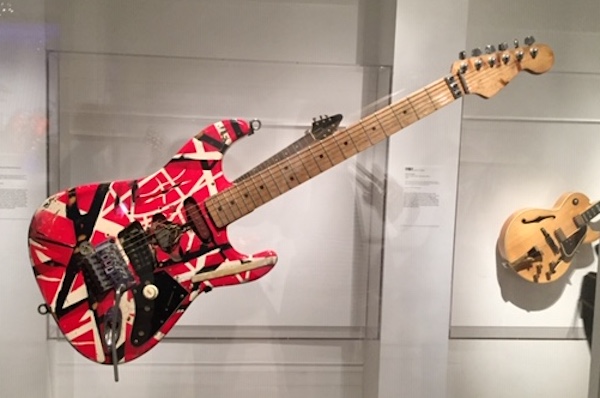

Contoured ash body, maple neck, 25-and-a-half inch scale, spray painted red finish with black and white stripes, PAF humbucking pickup at bridge, dummy neck pickup, single volume control, Floyd Rose locking vibrato system, 1971 quarter
Aptly named Frankenstein, this guitar was pieced together by Eddie Van Halen from modified factory seconds and mismatched odd-lot parts, then spray painted. It represents an effort to combine some of the most desirable elements of Gibson and Fender guitars into a single instrument that was not commercially available at the time. Van Halen was continually striving to achieve the ultimate guitar tone…This unique guitar embodies not only his groundbreaking and unorthodox playing style, but also ingenuity in design and engineering…It is also one of the most recognizable guitars of all time…

This 2018 Super ’78 Eruption guitar is an exact replica of the original configuration of Eddie Van Halen’s Frankenstein guitar, which he constructed himself…His original decoration used white spray paint for the body with black intersecting stripes. After this was widely copied, Van Halen repainted the guitar red with white-and-black stripes, its now-iconic configuration.

Peddleboard: MXR Flanger, MXR Equalizer, remote switches to control Univox Echo Chamber EC-80 A tape echo units, custom signal-switching boxes labeled 1 and 2, Maestro Echoplex, early 1970’s

Paul Stanley:
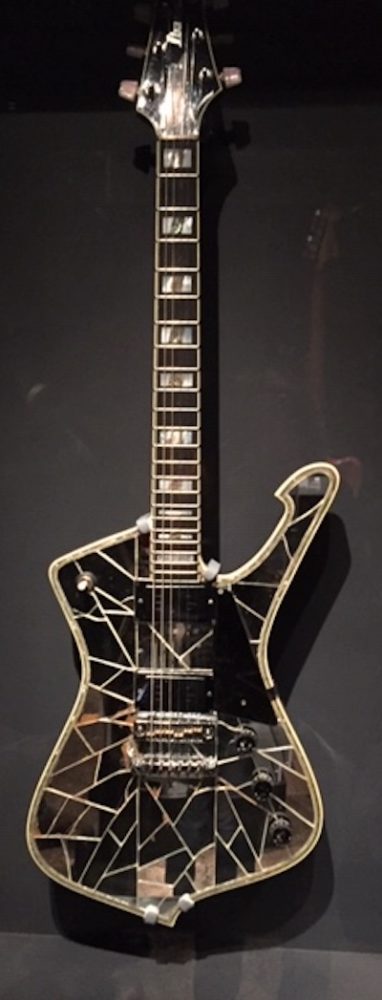
Paul Stanley of KISS collaborated with Jeff Hasselberger at Ibanez to create this instrument. Stanley, always seeking ways to elevate his showmanship, envisioned a mirrored covered guitar that looked like it was smashed at the pickups and whose shards could reflect stage lighting like a disco ball…
Angus Young:
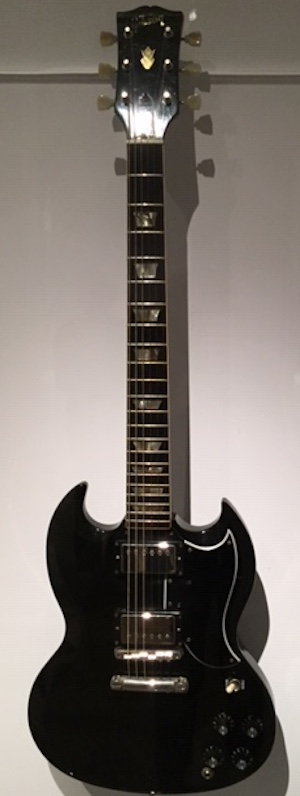
and-a-half inch scale; black finish; Two Seymour Duncan humbucking pickups, three-way selector switch, two volume and two tone controls.
Angus Young, a cofounder of the Australian hard rock band AC/DC, has used Gibson SG’s exclusively throughout his career with the band. He was initially attracted to the model because of its light weight and easy playability…Young has played this guitar since the 1980s in concerts including Live At Donington and Live At River Plate, and at the Grammy’s in 2105. It’s original vibrato tailpiece has been removed. Young never relied on effect to achieve his signature tones- just his guitar, amp and pre-amp.
Metallica:

and-a-half inch scale; black finish with chrome diamond plate top; active EMG 60 and 81 humbucking pickups, three-way selector switch, volume and tone control. Starclassic: Lars Ulrich Signature seven piece kit in Magnetic Orange finish with cymbals. Tama Drums, Seto, Aichi Japan, Avedis Zildijan Co, Norwell Mas. Ca: 2008. Maple, metal, plastic components; chrome-diamond plated Lars Ulrich signature snare, two bass drums, two mounted toms, two floor toms, hi-hats, crash cymbals, China trash cymbals. Aztec De La Chloe: Five-String Electric Bass. Tobias manufactured by Gibson Brands, Nashville TN Ca: 2007-08. Alder body with walnut center stripe, maple neck with walnut stripe, 34 inch scale, sunburst finish wood burned Aztec calendrical design, two active EMG J-bass single coil pickups, two volume and two tone controls. Spider 13 Electric Guitar KH-3 ESP Custom Shop, Tokyo and Los Angeles Ca: 1992. Alder body, maple neck, rosewood fingerboard, 24
and-a-half inch scale, black finish decals, active EMG 60 and 81 humbucking pickups, three way selector switch, two volume and tone controls.
James Hetfield’s second signature model, JH-2, is an Explorer-style guitar…This one-of-a-kind version features a chrome diamond plate top that Metallica provided to ESP Custom Shop. Hetfield began playing it on tour supporting albums Load (1996) and Reload (1997). Lars Ulrich uses a seven-piece kit built around the double bass drums…Ulrich’s step omits the standard ride cymbal in favor of crash and “thrash” cymbals. This set was used on Metallica’s 2008-10 World Magnetic tour. Robert Trujillo began using this five-string bass guitar, with an additional string below the standard four strings of most basses, on Metaliica’s 2008 World Magnetic tour…The design is based on an Aztec calendar that was created by Trujillo’s wife, artist Chloe Trujillo. Kirk Hammett’s guitar’s name comes from the decals of a spider and the number 13 on its body, which were designed by hardcore punk, metal, and skate artist Brian “Pushhead” Schroeder. He first used the instrument on tour in 1992 in support of the Black Album, and comtinues to use it on tours.
Steve Vai:
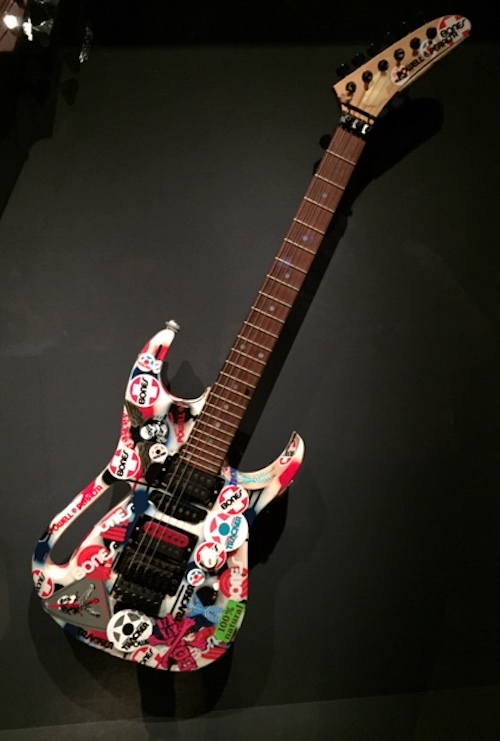
and-a-half inch scale, custom skateboard stickers, two DimMarzio humbucking pickups, one-single clot, five-way selector switch, one master volume control
Steve Vai ordered this guitar and three others-“Little Annie Fanny,” “Playboy and “Cowgirl”- from the Performance Guitar custom shop in the 1980’s…Vai introduced a pronounced cutaway design that allows access to all twenty-four frets on the fingerboard and floating vibrato design that could bend the strings up to around six semitones sharp. Vai later worked with Japanese guitar maker Ibanez to refine elements of the design, including a signature “monkey grip” cutout in the body for the long-running JEM series.
Jimmy Page:
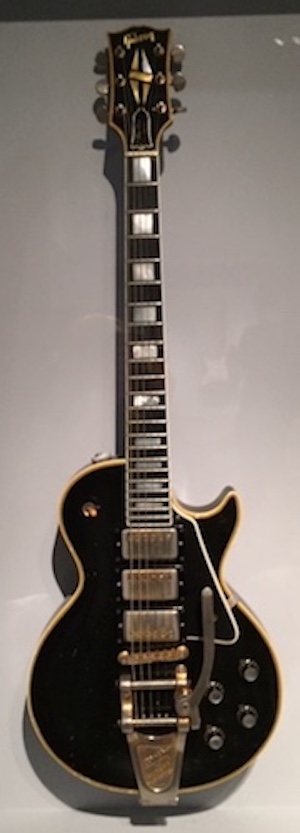
and-a-half inch scale; black finish, three PAF humbucking pickups, three-way selector switch, two volume and tone controls, Bigsby B7 vibrato
Jimmy Page acquired this Gibson Les Paul Custom in 1960 and used it as his main guitar for session work from 1962-1967, The guitar was stolen from the Minneapolis-Saint Paul airport in 1970, when Page took it on tour in the United States for the first time, and it returned to him on November 12th, 2015.
Jimi Hendrix:

and-a-half inch scale, Olympic white finish, three-single coil pickups, three-way selector switch, one volume and two tone controls.
Jimi Hendrix’s preference for Fender Stratocasters helped reestablished the instrument as its popularity waned in the late 1960s. He used this guitar for his legendary 1969 Woodstock performance, which culminated in his unplanned, radical reinterpretation of The Star Spangled Banner…Hendrix who was left-handed, famously played right-handed guitars upside down and restrung. He purchased this guitar in 1968; he also used it at the last 1969 Newport Pop Festival and his last official performance, at the Open Air Love and Peace Festival in Fehmarm, Germany on September 6th, 1970.
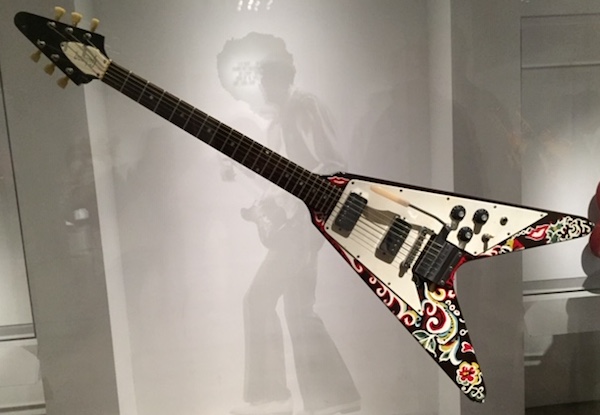
and-a-half inch scale; black finish with painted designs, two humbucking pickups, three-way selector switch, two volume and one tone control, Vibrola vibrato tailpiece.
Though known for playing Fender Stratocasters, Jimi Hendrix played this Gibson Flying V extensively from 1967-1969. He probably used it on his 1967 BBC 1 sessions and 1968’s Electric Ladyland, notably for his solo on All Along The Watchtower. Hendrix modified the nut and strap button and painted the instrument himself using nail polish. When he gave the guitar to Mick Cox of the Irish band Eire Apparent in1969, Cox refinished it in black and removed the original design. In the 1990s, session musician Dave Brewis acquired the instrument and restored Hendrix’s original paint job.
Related link: MET MUSEUM PICTURES PART TWO: JIMMY PAGE, JIMI HENDRIX, STEVIE RAY VAUGHAN, KEITH RICHARDS, THE BEATLES AND PAUL MCCARTNEY
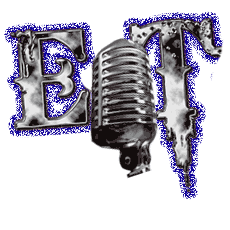

19 Responses
I’ll be up in NY/NJ in August, if I have the time, I’m definitely going to visit the museum! And Dana can be my tour guide! 😉
It would be my pleasure, I love that museum. Also, I know it like the back of my hand, for the most part, 🙂 .
Sounds great! Any Aerosmith instruments?
Yes, I think there was a Joe Perry guitar, but don’t quote me.
That would be awesome! Can’t wait to see it all! Are you allowed to touch any of the instruments?
No, of course not, they are all behind plexiglass.
Ugh! I knew that, but just thought that maybe some items? But it’s cool, even though you can only “Look But You Can’t Touch,” I’m still very much looking forward to visiting the museum.
You can get really close (if there are no crowds), so it’s the next best thing.
Did you have to pay $2,000 for the “meet & greet” with Paul Stanley’s guitar?…
LOL!!! My Mom volunteers, so it was actually free.
Hello Dana,
I was there last week at this time matter of fact and I agree with your statements. In fact, you took many of the same photos I did. I concur it’s a strange feeling seeing something like Hendrix”s Stratocaster peacefully displayed in front of you when you realize it’s history and who played it, same for the other displays. Me myself, I always loved that orange, sparkle finish on Lars Ulrich’s Tama set, (Especially in 3-D when it was in “Through the Never”) and I never thought I would see it up close, the same for Jimmy Page’s Les Paul & EVH’s Frankenstein. Other highlights for me were Ringo Starr’s 63 Ludwig set, Keith Emerson’s rig ( Listened to Tarkus & other ELP many a times) and the first Ovation acoustic guitar built for Nancy Wilson, being I have an Ovation myself and can remember way back in some music magazine a full page endorsement she did for the company. Liked seeing Annie Clark’s custom Ernie Ball guitar as well being I’m kind of a St. Vincent fan.
Disappointed that some parts of the museum were closed off, (Renaissance era paintings, some photography) but still managed to get lost once again and had to backtrack myself a few times. Was a nice walk up there, but going back near the five o clock hour, those horns can get annoying. Nothing is going to move any faster or anywhere for that matter. Thanks for reading.
Hi Rob,
I am so glad that you were able to experience this exhibit, as well.
There were quite a few guitars, that I did not include in the post, that I also took pictures of, and liked, as well.
Keith Richard’s Les Paul custom, on his which he did his own design was cool, and of course, Stevie Ray Vaughn’s strat with his SRV initials on the body. I was disappointed that Randy Rhoads was not included. He is my favorite, and talk about being influential in such a short period of time. I think if I saw any of his guitars displayed, I might have been moved to tears.
I thought the gear set up rooms, that included EVH (which is included in this post), Jimmy Page (which I also have pictures of), Keith Richards and Tom Morello, were very interesting, as well as, educational. Regarding St. Vincent, while I don’t know much about her, I thought her color choice of her guitar, chartreuse, was certainly, bold.
Also, like you, being a huge Beatles fan, I was also excited to see Paul’s basses, and their stage setup, as well. It was constantly crowded around that case.
Finally, I am sorry that some of the other exhibits were closed when you came, I do believe they are renovating some of the painting rooms. Have you ever been to the Astor Court in the Asian Wing? The Frank Lloyd Wright room in the American Wing? I LOVE that room and I am a huge fan of Wright’s architecture, windows, furniture, etc. What about the Temple of Dendur in the Egyptian wing? Also, I would think with the popularity of the show, Game of Thrones, the knights, and the arms and armor exhibit, would also be very popular.
Anyway, if you ever need any suggestions as to what to see, let me know, I know the museum can be a very overwhelming experience, because there is so much to see.
D 🙂
Thanks for sharing, Dana! Musical instruments surely are works of art.
As are the countless musicians who created iconic music on those instruments.
Yes Dana I have seen the rooms display on previous visits, and I was perusing the arms display again on this visit.
I believe the galleries with the paintings are being done over for better natural and artificial lighting.
Yeah I like Lloyd Wright’s work as well.
Sounds like you and I have a lot in common. 🙂
Ugh…I’ve always wanted to see the original Frankenstein
Well, if it means that much to you, get on a plane and visit. The exhibit is in here until October 1st. There is a ton to see in New York, so it is a worthwhile trip, despite our horrible mayor.
Worst “mayor” ever! That big d–khead is one of the reasons why I left NY! Yeah, he ran NYC alright, he ran it right into the ground!